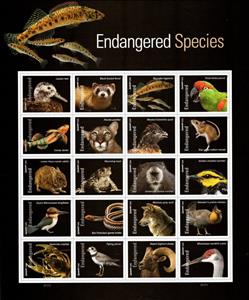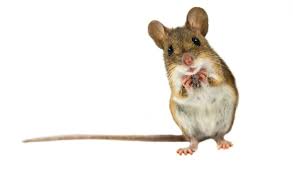Mini Sheet: Endangered Species (United States of America 2023)
Endangered Species (United States of America 2023)
19 May (United States of America ) within release Endangered Species Act, 50 Years (2023) goes into circulation Mini Sheet Endangered Species face value 20*FOREVER No Face Value
| Mini Sheet Endangered Species in catalogues | |
|---|---|
| Colnect codes: | Col: US 2023.05.19-01 |
Mini Sheet is vertical format.
Face value US$0.63 per stamp on day of issue.Also in the issue Endangered Species Act, 50 Years (2023):
- Stamp - Attwater's Prairie Chicken (Tympanuchus cupido attwateri) face value FOREVER;
- Stamp - Black-Footed Ferret (Mustela nigripes) face value FOREVER;
- Stamp - Candy Darter (Etheostoma osburni) face value FOREVER;
- Stamp - Desert Bighorn Sheep (Ovis canadensis nelsoni) face value FOREVER;
- Mini Sheet - Endangered Species face value 20*FOREVER;
- Stamp - Florida Panther (Puma concolor couguar) face value FOREVER;
- Stamp - Golden-Cheeked Warbler (Setophaga chrysoparia) face value FOREVER;
- Stamp - Guam Micronesian Kingfisher (Todiramphus cinnamominus) face value FOREVER;
- Stamp - Key Largo Cotton Mouse (Peromyscus gossypinus allapaticola) face value FOREVER;
- Stamp - Laysan Teal (Anas laysanensis) face value FOREVER;
- Stamp - Lower Keys Marsh Rabbit (Sylvilagus palustris hefneri) face value FOREVER;
- Stamp - Masked Bobwhite Quail (Colinus virginianus) face value FOREVER;
- Stamp - Mexican Grey Wolf (Canis lupus baileyi) face value FOREVER;
- Stamp - Mississippi Sandhill Crane (Antigone canadensis) face value FOREVER;
- Stamp - Nashville crayfish (Faxonius shoupi) face value FOREVER;
- Stamp - Piping Plover (Charadrius melodus) face value FOREVER;
- Stamp - Roanoke Logperch (Percina rex) face value FOREVER;
- Stamp - San Francisco Garter Snake (Thamnophis sirtalis tetrataenia) face value FOREVER;
- Stamp - Thick-Billed Parrot (Rhynchopsitta pachyrhyncha) face value FOREVER;
- Stamp - Vancouver Island Marmot (Marmota vancouverensis) face value FOREVER;
- Stamp - Wyoming Toad (Anaxyrus baxteri) face value FOREVER;
- Mini Sheet - Endangered Species No Die Cut face value 20*FOREVER;
Mini Sheet Endangered Species it reflects the thematic directions:
Animals are multicellular, eukaryotic organisms of the kingdom Animalia (also called Metazoa). All animals are motile, meaning they can move spontaneously and independently, at some point in their lives. Their body plan eventually becomes fixed as they develop, although some undergo a process of metamorphosis later on in their lives. All animals are heterotrophs: they must ingest other organisms or their products for sustenance.
Birds (Aves), a subgroup of Reptiles, are the last living examples of Dinosaurs. They are a group of endothermic vertebrates, characterised by feathers, toothless beaked jaws, the laying of hard-shelled eggs, a high metabolic rate, a four-chambered heart, and a strong yet lightweight skeleton. Birds live worldwide and range in size from the 5 cm (2 in) bee hummingbird to the 2.75 m (9 ft) ostrich. They rank as the class of tetrapods with the most living species, at approximately ten thousand, with more than half of these being passerines, sometimes known as perching birds. Birds are the closest living relatives of crocodilians.
The cougar (Puma concolor) (/ˈkuːɡər/, KOO-gər), also known as the panther, mountain lion, catamount and puma, is a large cat native to the Americas. It inhabits North, Central and South America, making it the most widely distributed wild, terrestrial mammal in the Western Hemisphere, and one of the most widespread in the world. Its range spans the Canadian Territory of Yukon, British Columbia and Alberta provinces, the Rocky Mountains and areas in the Western United States. Further south, its range extends through Mexico to the Amazon Rainforest and the southern Andes Mountains in Patagonia. It is an adaptable, generalist species, occurring in most American habitat types. It prefers habitats with dense underbrush and rocky areas for stalking but also lives in open areas.
A fish is any member of a group of animals that consist of all gill-bearing aquatic craniate animals that lack limbs with digits. They form a sister group to the tunicates, together forming the olfactores. Included in this definition are the living hagfish, lampreys, and cartilaginous and bony fish as well as various extinct related groups. Tetrapods emerged within lobe-finned fishes, so cladistically they are fish as well. However, traditionally fish are rendered obsolete or paraphyletic by excluding the tetrapods (i.e., the amphibians, reptiles, birds and mammals which all descended from within the same ancestry). Because in this manner the term "fish" is defined negatively as a paraphyletic group, it is not considered a formal taxonomic grouping in systematic biology. The traditional term pisces (also ichthyes) is considered a typological, but not a phylogenetic classification. The earliest organisms that can be classified as fish were soft-bodied chordates that first appeared during the Cambrian period. Although they lacked a true spine, they possessed notochords which allowed them to be more agile than their invertebrate counterparts. Fish would continue to evolve through the Paleozoic era, diversifying into a wide variety of forms. Many fish of the Paleozoic developed external armor that protected them from predators. The first fish with jaws appeared in the Silurian period, after which many (such as sharks) became formidable marine predators rather than just the prey of arthropods. Most fish are ectothermic ("cold-blooded"), allowing their body temperatures to vary as ambient temperatures change, though some of the large active swimmers like white shark and tuna can hold a higher core temperature. Fish are abundant in most bodies of water. They can be found in nearly all aquatic environments, from high mountain streams (e.g., char and gudgeon) to the abyssal and even hadal depths of the deepest oceans (e.g., gulpers and anglerfish). With 33,100 described species, fish exhibit greater species diversity than any other group of vertebrates. Fish are an important resource for humans worldwide, especially as food. Commercial and subsistence fishers hunt fish in wild fisheries (see fishing) or farm them in ponds or in cages in the ocean (see aquaculture). They are also caught by recreational fishers, kept as pets, raised by fishkeepers, and exhibited in public aquaria. Fish have had a role in culture through the ages, serving as deities, religious symbols, and as the subjects of art, books and movies.
A mouse (pl.: mice) is a small rodent. Characteristically, mice are known to have a pointed snout, small rounded ears, a body-length scaly tail, and a high breeding rate. The best known mouse species is the common house mouse (Mus musculus). Mice are also popular as pets. In some places, certain kinds of field mice are locally common. They are known to invade homes for food and shelter.
Parrots (Psittaciformes), also known as psittacines (/ˈsɪtəsaɪnz/), are birds with a strong curved beak, upright stance, and clawed feet. They are classified in four families that contain roughly 410 species in 101 genera, found mostly in tropical and subtropical regions. The four families are the Psittaculidae (Old World parrots), Psittacidae (African and New World parrots), Cacatuoidea (cockatoos), and Strigopidae (New Zealand parrots). One-third of all parrot species are threatened by extinction, with a higher aggregate extinction risk (IUCN Red List Index) than any other comparable bird group Parrots have a generally pantropical distribution with several species inhabiting temperate regions as well. The greatest diversity of parrots is in South America and Australasia
Sheep (pl.: sheep) or domestic sheep (Ovis aries) are a domesticated, ruminant mammal typically kept as livestock. Although the term sheep can apply to other species in the genus Ovis, in everyday usage it almost always refers to domesticated sheep. Like all ruminants, sheep are members of the order Artiodactyla, the even-toed ungulates. Numbering a little over one billion, domestic sheep are also the most numerous species of sheep. An adult female is referred to as a ewe (/juː/ yoo), an intact male as a ram, occasionally a tup, a castrated male as a wether, and a young sheep as a lamb.







